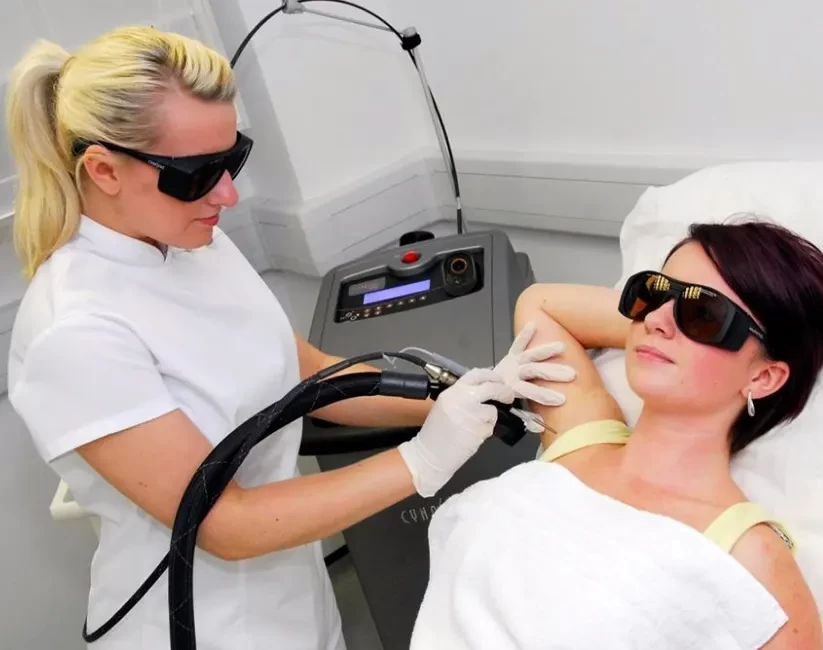
Introduction:
Laser hair removal is a medical procedure that uses a concentrated beam of light (laser) to remove unwanted hair.
During laser hair removal, a laser emits a light that is absorbed by the pigment (melanin) in the hair. The light energy is converted to heat, which damages the tube-shaped sacs within the skin (hair follicles) that produce hairs. This damage inhibits or delays future hair growth.
Although laser hair removal effectively delays hair growth for long periods, it usually doesn't result in permanent hair removal. Multiple laser hair removal treatments are needed for initial hair removal, and maintenance treatments might be needed as well. Laser hair removal is most effective for people who have light skin and dark hair, but it can be successfully used on all skin types.
Complication:
Risks of side effects vary with skin type, hair color, treatment plan and adherence to pre-treatment and post-treatment care. The most common side effects of laser hair removal include:
Skin irritation. Temporary discomfort, redness and swelling are possible after laser hair removal. Any signs and symptoms typically disappear within several hours.
Pigment changes. Laser hair removal might darken or lighten the affected skin. These changes might be temporary or permanent. Skin lightening primarily affects those who don't avoid sun exposure before or after treatment and those who have darker skin.
Prepare:
The specific instructions to prepare for laser hair removal. These might include:
- Staying out of the sun. for avoiding sun exposure before and after treatment. Whenever you go out, apply a broad-spectrum, SPF30 sunscreen.
- Lightening your skin. Avoid any sunless skin creams that darken your skin.
- Avoiding other hair removal methods. Plucking, waxing and electrolysis can disturb the hair follicle and should be avoided at least four weeks before treatment.
- Avoiding blood-thinning medications, such as aspirin or anti-inflammatory drugs, to avoid before the procedure.
- Shaving treatment area. Trimming and shaving is recommended the day before laser treatment. It removes hair above the skin that can result in surface skin damage from burnt hairs, but it leaves the hair shaft intact below the surface.
After the procedure:
You might notice redness and swelling for the first few hours after laser hair removal.
To reduce any discomfort, apply ice to the treated area. If you have a skin reaction immediately after laser hair removal, apply a steroid cream to the affected area.
After laser hair removal and between scheduled treatments, avoid sunlight and don't use a tanning bed for six weeks. Use a broad-spectrum SPF30 sunscreen daily.
Cynosure Elite+
Cynosure Elite+ laser machine is a single consolidated system that delivers a range of treatments - all skin type hair removal, as well as pigmented and vascular lesions.
Cynosure Elite+ works in two modes Alexandrite laser, dual wavelength 755 nm with the Nd-YAG laser, dual wavelength 1064 nm.
755nm Alexandrite laser & 1064nm ND-Yag LaserThe device performs the following treatments:
- Hair removal for all skin types from 1 to 6 (from 1 to 4 using the Alexandrite laser and from 4 to 6 using the Nd.YAG laser) by easily switching between both lasers during one session according to the skin type.
- Treatment of superficial and deep pigmentation such as age spots and pigmentation resulting from sun damage and freckles, using the Alexandrite laser, which is the appropriate laser for treating age-related pigmentary lesions, due to its high absorption of melanin.
- Removing hair on tanned skin without any burns and without side effects, as the Nd.YAG laser is the appropriate option for treating hair on dark skin and tanned skin without destroying the surrounding tissue or causing any burns, due to its medium absorption in melanin, which is found in dermal tissue.
- Treatment of microvascular expansions, including large and large, in the face and body by Nd.YAG laser, which is considered the golden laser for these treatments, as the absorption of this laser is average in melanin, but very high in hemoglobin, which leads to vasoconstriction.
- The device renews the freshness of the facial skin through the thermal effect resulting from the laser, which helps to stimulate collagen and stimulate blood circulation.
